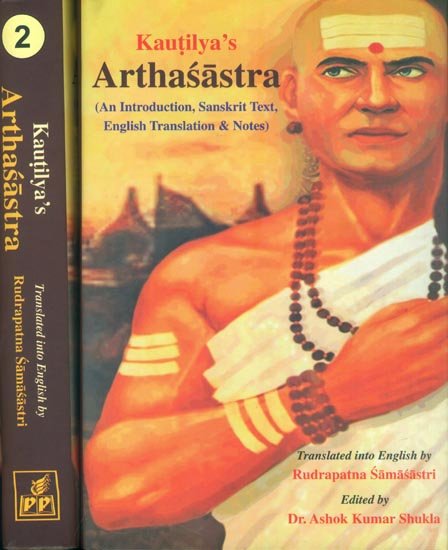Kautilya Arthashastra
by R. Shamasastry | 1956 | 174,809 words | ISBN-13: 9788171106417
The English translation of Arthashastra, which ascribes itself to the famous Brahman Kautilya (also named Vishnugupta and Chanakya) and dates from the period 321-296 B.C. The topics of the text include internal and foreign affairs, civil, military, commercial, fiscal, judicial, tables of weights, measures of length and divisions of time. Original ...
Chapter 4 - Battlefields and the Work of Infantry, Cavalry, Chariots and Elephants
[Sanskrit text for this chapter is available]
Favourable position for infantry, cavalry, chariots, and elephants are desirable both for war and camp.
For men who are trained to fight in desert tracts, forests, valleys, or plains, and for those who are trained to fight from ditches or heights, during the day or night, and for elephants which are bred in countries with rivers, mountains, marshy lands, or lakes; as well as for horses, such battlefields as they would find suitable (are to be secured).
That which is even, splendidly firm, free from mounds and pits made by wheels and footprints of beasts, not offering obstructions to the axle, free from trees, plants, creepers and trunks of trees, not wet, and free from pits, ant-hills, sand, and thorns, is the ground for chariots.
For elephants, horses and men, even or uneven grounds are good, either for war or for camp.
That which contains small stones, trees and pits that can be jumped over, and which is almost free from thorns, is the ground for horses.
That which contains big stone, dry or green trees and ant-hills, is the ground for the infantry.
That which is uneven with assailable hills and vallys [valleys?], which has trees that can be pulled down and plants that can be torn, and which is full of muddy soil free from thorns, is the ground for elephants.
That which is free from thorns, not very uneven, but very expansive, is an excellent ground for the iṇfantry.
That which is doubly expansive, free from mud, water and roots of trees, and which is devoid of piercing gravel, is an excellent ground for horses.
That which possesses dust, muddy soil, water, grass and weeds, and which is free from thorns (known as dog’s teeth) and obstructions from the branches of big trees, is an excellent ground for elephants.
That which contains lakes, which is free from mounds and wet lands, and which affords space for turning, is an excellent ground for chariots.
Positions suitable for all the constituents of the army have been treated of. This explains the nature of the ground which is fit for the camp or battle of ail kinds of the army.
Exploration on occupied positions, camps and forests; holding strategic positions, water, fording places, and positions agreeable with the direction of the wind and the sun; destruction or protection of the commissariat and of troops arriving afresh; supervision of the discipline of the army; lengthenine [lengthening?] the line of the army; protecting the sides of the army; first attack; dispersion (of the enemy’s army); trampling it down; defence; seizing; letting it out; causing the army to take a different direction; carrying the treasury and the princes; falling against the rear of the enemy; chasing the timid; pursuit; and concentration—these constitute the work of horses.
Marching in the front; preparing the roads, camping grounds and path for bringing water; protecting the sides; firm standing, fording and entering into water while crossing pools of water and ascending from them; forced entrance into impregnable places; setting or quenching the fire; the subjugation of one of the four constituents of the army; gathering the dispersed army; breaking a compact army; protection against dangers; trampling down (the enemy’s army); frightening and driving it; magnificence; seizing; abandoning; destruction of walls, gates and towers; and carrying the treasury—these constitute the work of elephants.
Protection of the army; repelling the attack made by all the four constituents of the enemy’s army; seizing and abandoning (positions) during the time of battle; gathering a dispersed army; breaking the compact array of the enemy’s army; frightening it; magnificence; and fearful noise—these constitute the work of chariots.
Always carrying the weapons to all places; and fighting—these constitute the work of the infantry.
The examination of camps, roads, bridges, wells and rivers; carrying the machines, weapons, armours, instruments and provisions; carrying away the men that are knocked down, along with their weapons and armours—these constitute the work of free labourers.
* The king who has a small number of horses may combine bulls with horses; likewise when he is deficient in elephants he may fill up the centre of his army with mules, camels and carts.
[Thus ends Chapter IV, “Battlefields; the Work of Infantry, Cavalry, Chariots and Elephants,” in Book X, “Relating to War” of the Arthaśāstra of Kauṭilya. End of the hundred and thirty-second chapter from the beginning.]
